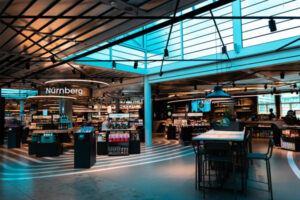As retail markets develop, the role of commercialization is becoming increasingly important. It is also claiming an independent role within the scope of professional property management. This is all the more true because commercialization should represent up to 5-10% of the total net operating income (NOI) of a commercial asset. This alone sheds enough focus on this service line, especially when we analyze how and when it overlaps with traditional leasing and how landlords can maximize revenues without creating a constant conflict between long-term and short-term retailers.
Commercialization, as a short-term leasing format of non-GLA areas, usually takes diverse forms such as Retail Merchandising Units (RMU’s), kiosks, and other types of point-of-sale always intended to be positioned either in high-frequency areas within the mall or specifically attached to certain anchors, profiles, or clusters, thus leveraging the complementary role of these vending modes.
WALKING ON BOTH SIDES?
As retailers learned the ways of landlords and experienced the sobering repercussions of the financial crisis in the real estate sector, some of them decided to take the cautious approach and, instead of signing long-term leases, intended to “try” shopping centers by using a RMU or a kiosk with an option to switch to a proper unit upon expiry. It is easier and cheaper, however, to stay with the kiosk and improve the merchandise mix within the limitations of the kiosk/RMU space than to invest in a unit and commit to higher costs for a much longer period than, for instance, a twelve-month extension of the existing short-term lease. The “stay or go” freedom of short term leases creates the real value and buzz in commercialization and what makes a well operated shopping center lively as an addition to the slower changing, though hopefully well thought through, tenant mix.
This is where the responsibility of the property manager comes in. It is understood that, in an ideal world, established brands take GLA and, with the proper strategy, ensure the necessary footfall and turnover, while commercialization is focused on the opportunity-driven, “wannabe,” or simply experimental brands and activities that are supposed to be perfectly blended into the big picture and should play a complementary role by adding profiles and brands not present in the GLA.
A VERY THIN LINE
Despite the fact that there is a clear distinction between GLA and non-GLA tenants, the problem that property managers increasingly face is how to properly reflect this distinction in the leases. The line between commercial leasing and commercialization is sometimes a very thin one. Good managers align longer-term strategies by fixing long-term and established players on GLA while securing and constantly revising short-term leases on non-GLA areas and encouraging short-term tenants to convert to longer terms once they have carefully evaluated their performance, brand, and functional value for the overall shopping center. This way, commercialization has an immense role in vitalizing, enhancing, and refreshing the offer.
The interest of the owner, something that always drives professional property managers, is best served by this everyday cooperation between leasing and commercialization. We can therefore clearly state that these two service lines are far from being foes—they are the strongest allies in securing the delivery of the required KPIs of a commercial asset in the long run.
ABOUT TRIGRANIT MANAGEMENT
TriGranit Management has been managing shopping centers throughout the CEE region over the last 20 years with outstanding experience of fine tuning and improving leasing and commercialization strategies. It has also been successfully transferring this know-how to new markets, such as the Middle East, the Caucasus region, and mainland China.






